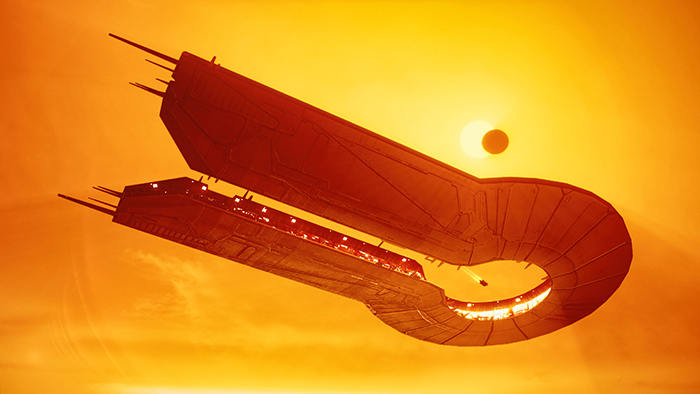

OUT OF CHARACTER INFORMATION
- Intent: Create Shipyards for Pri-Andylan Propulsion Systems and Duro.
- Image Source:
- Bentusi cargo transfer at Amber Nebula. 4k wallpaper - u/Lord_Pelaxus
- The Great Harbour Ship of Bentus
- Homeworld 2 - Gearbox Software, Relic Entertainment
- Company Logo:
- Canon Link: N/A
- Permissions: MandalMotors: Vencuyot II Mandalorian Shipyard, Primo Victorian: Lucian-Type Defense System, Mandalorian Steel
- Primary Source: Vencuyot II Mandalorian Shipyard
- Manufacturer: Pri-Andylan Propulsion Systems
- Affiliation: Pri-Andylan Propulsion Systems, Closed-Market
- Model: Orbital Construction Station
- Production: Semi-Unique
- Material:
- Durasteel (Reactive Plating)
- Quadranium Alloy (Hull Plating)
- Frasium (Ablative Armour)
- Trimantium (Hull Lining)
- Titanium (Hull Reinforcements)
- Mandalorian Steel (Internal and Supportive Superstructures)
- Isotope-5 (Reactors)
- Classification: Shipyards
- Length: 9’500 metres
- Width: 7’000 metres
- Height: 3’000 metres
- Armament: None
- Defences: Extreme
- Point-Defence Laser Cannons
- Flak Guns
- Tractor & Pressor Beams
- Ablative Armour and Hull Plating
- Reactive Plating
- Anti-Ion Mesh
- Deflector Shields
- Main Molecular Shields
- Lucian-Class Defense System
- Redundant Deflector Shields
- Ion Shields
- Cap Drain
- Electronic Countermeasures
- Dampener Aerosol Dispersers (Internal: Hallways)
- Sensor Jammers
- Communication Jammers
- Hangar Space:
- Civilian Hangars Open to Customers
- Employee-Only Hangars
- Capital Ship Docking Bays
- Interconnected System of Cargo Holds
- Starship Refueling Station Docking Bays (Capital Ship and Personal sized)
- Manoeuvrability Rating: Very High
- Speed Rating: Very High
- Hyperdrive Class: Very Low: 10
- Ion Shields
- Regular Powered Deflector Shields (Redundant)
- Tractor & Pressor Beams
- Point-Defence Laser Cannons
- Flak Guns
- Electronic Countermeasures
- Dampener Aerosol Dispersers
- Life Support Systems
- Damage Control Systems
- Sensor Arrays
- Navigational Arrays & Avionics Systems
- Communication Arrays
- Holonet Transceivers
- Emergency Manoeuvring Thrusters
- Starship Refueling Stations (Capital Ship and Personal Sized)
- Starship Construction & Assembly Bays (Capital Ship and Personal Sized)
- Starship Part Production Facilities
- Employee Housing
- Hydroponic Bay
- Southstar-Class Battle Droids (Security Force Supplement)
- Promenade Deck with Spiritual Centres
- Scientific Research Facilities
- R&D Facilities
- Medical Station with Full Quarantine Capabilities
- Public Super-Store Complex
- Public Café and Diner Mile
- Gift Shop
- Isotope-5 Reactors
- Molecular Shield Arrays
- Lucian-type Defense System
- PulseScreen Quick-Recharge Shield Arrays (Redundant)
- Cap Drain
- Sensor Jammers (Military Grade)
- Communication Jammers (Military Grade)
- Molecular Furnaces (Recycling & Waste Disposal)
- HS-10 “Hermes” Class Hyperdrive
- AEGIS SH13LD
STRENGTHS
- Rock Solid: The Tayana-Class Shipyards have top of the line defensive systems, ranging from its advanced Mandalorian Steel skeleton and Quadanium plating to its Isotope-5 Powered Deflector Shield Arrays, Lucian-Class Defense System and multiple Redundant Shield Generators. It also sports several alternative methods of defence against more unconventional forms of attack, like Electronic Countermeasures, Ion Shielding, Flak Guns, or Cap Drains, among others.
- Green and Clean: Already a marvel of logistics and planning, the Tayana Shipyards produce extraordinarily few waste materials. This is a result of the Duros people’s collective focus on sustainable resources and clean energy. In addition to the already low environmental burden, any potential waste is further reduced by Molecular Furnaces which can repurpose all unneeded material into such things as merchandise or souvenirs sold in the shipyards’ gift shop.
- Pacifist (Nigh-)Utopia: Purpose-built for the construction of Starships of all sizes, the Tayana-Class Shipyards have no direct way of defending itself against attacking fleets, whether they be three small pirate boats or a fully-fledged invasion fleet. With no guns of its own, the Shipyards are dependent on a security fleet for protection. Without one they present easy pickings for any dedicated and patient assailant with a big hungry Life Day sack.
- Exposed Isotope-5 Reactors: As a holdover from the Vencuyot II and part of an initiative to cut back on the usage of environmentally hazardous coolants, the Isotope-5 Reactors' main cooling is accomplished through radiators that expel heat directly into the freezing cold of space. This has left the reactors exposed and open to access by starships and space-suit wearing individuals.
DESCRIPTION
Following the reconstruction of Duro, Pri-Andylan Propulsion Systems looked to the stars for its next big project. To maintain employment of its many workers, Ced commissioned the creation of several shipyards that would rival and surpass those of old.
The Tayana-Class shipyard is a model of orbital construction station. The outer hull bears the appearance of an antiquated key that was hollowed out along its centre. It has enough space to facilitate the construction and repairs of several capital ships at once, able to attach and service three to four battle cruisers simultaneously. Especially large ships such as the rare star dreadnoughts or other space stations can also be serviced at these shipyards, though they require several of the stations to work in tandem, an undertaking that comes with many logistical nightmares that the stations' creators would rather not think about.
The shipyards have their own propulsion systems, allowing them to remain mobile. However, relocation during times when the shipyards aren't empty could cause great stress on the ship-stabilisers and lead to collision disasters of unfathomable scales. As such the shipyards tend to remain stationary during normal operation, however, exceptions are made for unconventionally large jobs. In such cases, the shipyards’ mobility is used to move them around the object being operated upon. This allows for a great deal of flexibility during construction or repair often unmatched by other shipyards.
In addition to its ability to repair, retrofit, and construct ships, the Tayana-Class also provides housing for its workers and any crews belonging to docked ships. Extensive housing decks, supported by self-sufficient hydroponic bays, line the two long arms of the station, with publicly accessible Super-Stores Complexes, Diners, Cafés, as well as long and short term housing options all located in the semi-circular bridge at the stations' aft. This is also the location of its popular promenade deck, where workers and customers can mingle or remain in their own private restricted sections.
The creation of a base skeleton to build upon would take years without an established orbital construction presence. In order to accelerate the timeline, Pri-APS looked to MandalMotors for support. On the recommendation of an intern from Mandalorian space, the board of directors proposed a deal to purchase unfinished Vencuyot II Shipyard frames as the base for their own designs, which the kind Mr Farthen was kind enough to accept. With the Vencuyot as a base, construction of the Tayana-class Shipyards could begin in earnest.
It was decided very early on that one of the most important pillars of construction would be minimal environmental impact caused by the stations' construction and operation. The people of Duro still remember the exile from its surface they were forced to undertake as a result of their careless pollution of the environment, vowing to never again destroy their own home the way their ancestors had. For this reason, the shipyards were designed to maximise waste reduction and minimise excess radiation creation. To this end, Isotope-5 Reactors are employed due to their high power to waste material ratios, powering a majority of the stations' systems and supplemented by large solar panels. Additionally, the shipyards employ molecular furnace technology in order to recycle any waste produced by production processes as well as the vast quantities of coolant required to keep the shipyards running.
As part of the cultural revival of their people, the CEO of Pri-APS saw it fitting to name the shipyards the Tayana-Class, after the Duro capital city and the memorial site to an age of greater prosperity. With so much of the Duros’ cultural identity invested into the shipyards, Pri-APS saw it fitting to provide only the most capable defence systems on the market, so that a repeat of the events that occurred during the Yuuzhan Vong wars would not come to pass again.
A Mandalorian Steel skeletal structure provides increased structural integrity, while a multi-layered system of hull platings intended to resist even the harshest turbolaser bombardment long enough to evacuate the stations' many workers should the shields be breached.
Overcoming the shipyards’ shields would provide a significant challenge for any assailant short of a full-sized attack fleet, however, with molecular shielding powered by several dedicated Isotope-5 reactors, multiple layers of redundant shielding, alongside ion shields, and the top-of-the-line Lucian-Class Defense System provided by the highly esteemed Primo Victorian Shipwright Company.
Prudently, Pri-APS has signed contracts with AEGIS Systems to provide its excellent services in holonet security and electronic warfare countermeasures. Systems that are further protected by an overarching Anti-Ion Mesh and Cap Drains, keeping the shipyards’ systems well guarded against electromagnetic attacks as well.
Military Grade Sensor and Communications Jammers have also been incorporated into the design, meant to confuse and scramble any attacking force, slowing them down until a friendly relief force can arrive.
Should the stations' situation be truly desperate, Jaeger Systems has kindly provided its HS-10 “Hermes” Hyperdrive to be incorporated into the stations' propulsion systems, allowing the station to escape into a better-defended system should the need ever arrive. Of course, this hyperdrive is not exclusive to emergencies and acts as the stations' main method of independent interstellar travel, though the relocation of a station of this scale requires extensive preparation work and cannot be done at the drop of a hat, lest the station incurs structural damage.
The only methods to deal with threats actively available to the station are its point-defence cannons and flak guns, capable of destroying any incoming missiles and physical projectiles, all the way up to starfighter-sized threats. To deal with asteroids and similar sized debris, the station employs an extensive network of tractor and pressor beams, also used during ship stabilisation at the start of repair or retrofit procedures.
Internally the stations are crewed by Duros security forces, supplemented by AEGIS’ Southstar-class Battle Droid security forces, in order to keep the peace on the station and defend it in case of a hull breach. For smaller altercations and customer safety, the station is equipped with Dampener Aerosol Dispersers within many of its hallways in the publicly accessible sections of the station, capable of reducing the lethal bolt of a blaster to little more than a painful sting. This measure was implemented to save as many lives as possible before security forces arrive on the scene, releasing automatically and explosively as soon as a blaster gas emission is detected.
Last edited by a moderator:




